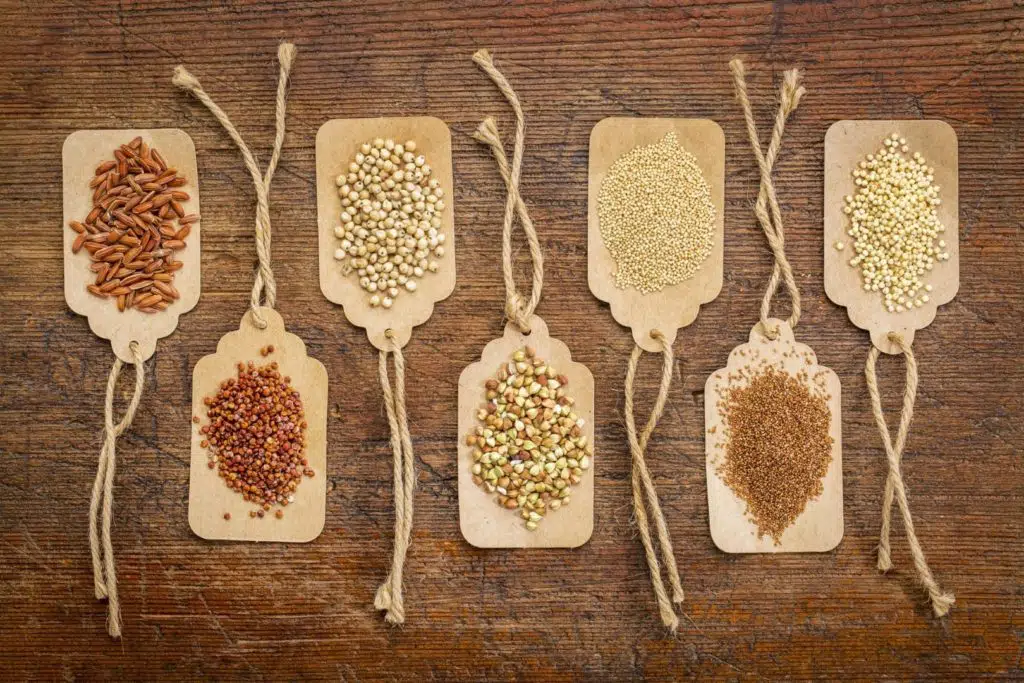If you’re kefirising in order to get on top of a skin condition or autoimmune disorder, we recommend eating “good grains” to help support the action of the kefir inside your system.
What’s a good grain?
Let’s start by examining what’s NOT a good grain. In a word – wheat.
I know, it’s bad news, but unfortunately, wheat – which we put into just about everything – is a bad grain. This is true for two reasons:
- Wheat contains gluten. Gluten is a nasty allergen that will trigger your skin condition and IBS.
- Wheat is high-GI, which means that it is burned into sugar very rapidly inside your system.
What does high-GI mean?
Everything your body eats is turned into sugar, or glucose. The question is how fast this happens.
Think of your body as a fireplace, and your food as fuel. High-GI (Glycemic Index) foods are converted to sugar very quickly inside your system, like burning newspaper in a fireplace.When you burn paper it flares rapidly, then disappears. This is exactly what happens when you eat high-GI foods like bread, pasta, rice and white potatoes. Your system releases a huge wave of insulin to deal with the sudden wave of sugar, and this insulin wave damages your microbiome.
Over time, this continual peak-and-drop of insulin will give you type 2 diabetes, as your insulin system gets exhausted.
So to protect those hard-working bugs inside your system, that you’re boosting with your daily dose of kefir, you want to eat foods that are low-GI. Low-GI foods burn slowly inside your system – like burning solid wood in your fireplace, instead of loads of paper. This slow-burning food releases a constant trickle of sugar, which keeps your microbiome ticking along nicely without damaging it.
This means that bread and pasta made with wheat, (as well as rice and white potatoes, because they’re also high-GI) are off the menu while you kefirise and get your issues under control.
The problem is that here in the west, we are absolutely addicted to wheat, and we put it into everything!
Other cultures around the world do a better job than we do on this count. They tend to consume more different kinds of grains. The Russians eat buckwheat for breakfast, and call it kasha. (Despite it’s name, buckwheat is not related to wheat, and is a great example of a good grain – low-GI and gluten-free.) The Japanese make their soba noodles out of buckwheat. Amaranth is consumed regularly in Africa, Indonesia, China and India – but few of us in the UK have even heard of it!
So we’ve taken one grain, wheat – that’s not very good for us – and used it exclusively in almost everything we eat. We’re going to have to push those grain boundaries out a bit, and adopt some better grain choices from our neighbours around the world.
What are these good grains?
Oatmeal
This is the old classic, but it’s as good as food gets. Low-GI and gluten-free, as well as being anti-inflammatory. A bowl of porridge in the morning in the perfect breakfast, especially if you add a spoonful of coconut oil, a handful of blueberries. Oatmeal itself is gluten-free. If you’re coeliac, it’s worth dishing out the extra money for gluten-free oatmeal, but all this means is that it’s been grown in an exclusion zone where no bird can drop a seed of anything other than oatmeal, thus avoiding gluten contamination.
Buckwheat
Despite it’s name, this gluten-free, low-GI beauty is not related to wheat! While most people think of buckwheat as a whole grain, it’s actually a seed that is high in both protein and fibre. It supports heart and heart health and can help prevent diabetes and digestive disorders. In fact, buckwheat seeds, also called “groats,” are so packed with nutrients and antioxidants that they are often called “superfoods.”Commonly eaten as roasted buckwheat groats, you can go with sweet or savoury toppings to this nutty-tasting grain. To cook dried buckwheat groats, rinse them well and then combine with water on the stovetop in a 2:1 ratio, so two cups of water for every one cup of buckwheat. Simmer them on low for about 20 minutes, checking to see when they are plump and their texture is what you’re looking for. If they aren’t absorbing all the water and appear to become mushy, try straining some of the water out (some people prefer to use only 1.5 cups of water to one cup of buckwheat to prevent this from happening).
Amaranth
Amaranth is a native crop in Peru, and it’s grown in Africa, India, China, Russia, South America and North America. The grain is gaining popularity today because of its startling health benefits. It’s a great source of protein, reduces inflammation, improves bone health, lowers cholesterol, fights diabetes, aids digestive health and promotes weight loss. When cooking amaranth grain, use the ratio of 1 1/2 cups water to 1/2 cup amaranth. Heat the mixture in a small saucepan until it begins to boil. Then reduce the heat and let it simmer, uncovered, until the water is absorbed. This typically takes about 20 minutes.
Quinoa
Quinoa (pronounced KEEN-wah) is a 7,000 year old grain that originated in the mountainous regions of South America. Quinoa has gained a lot of popularity over the last few years due to its significant nutrition and health benefits. Quinoa is high in protein, gluten-free, a great source of fibre, antioxidant, good for heart health and weight loss, a nutritious superfood, helps prevent cancer and diabetes, fights disease, and is very plain tasting, so is very versatile. To cook quinoa, you need 1 cup of uncooked quinoa to 2 cups of liquid. Bring quinoa and liquid to a boil in a medium saucepan. Reduce heat to low, cover and simmer until tender and most of the liquid has been absorbed, 15 to 20 minutes. Fluff with a fork.
Millet
If you think millet sounds like bird food, you’re not alone! While widely referred to as a grain, millet is actually a seed. And while birds do love it, it’s easy to see why humans choose it, too. It’s naturally gluten-free, high in fiber and low on the glycemic index, keeping your blood sugar levels stable. It’s also an alkaline food, meaning it’s easily digestible, a good option for those with sensitive stomachs. If you’ve never cooked with millet, you’ll be pleasantly surprised. Depending on how it’s cooked, millet recipes can have a creamy texture like mashed potatoes or a fluffier, slightly crunchy one like quinoa or rice. To cook millet, you’ll need 1 cup of raw millet and 2 cups of cooking liquid (water or broth). In a large, dry saucepan, toast the raw millet over medium heat for 4-5 minutes or until it turns a rich golden brown and the grains become fragrant. Add the water and and a pinch of sea salt to the pan, stir. Increase the heat to high and bring the mixture to a boil. Lower the heat and simmer until the grains absorb most of the water (they’ll continue soaking it up as they sit), about 15 minutes. Avoid the temptation to peek a great deal or stir too much (unless its sticking to the bottom). Stirring too vigorously will break up the grains and change the texture. Remove from heat and let stand. Like most grains, millet needs a little time off the heat to fully absorb the liquid. Allow it to sit, covered and removed from heat, for 10 minutes. Fluff and Serve!
Think food bowls, not sandwiches
When you’re thinking about grains, think about making a bowl of food. Usually we use wheat products as a base for things, and then we load stuff on top. Bread makes a sandwich, pasta gets sauce on top, pizza dough gets – well, pizza toppings.
The other things we use as bases to fill us up in the UK are commonly jacket potatoes – another bad choice, as large white potatoes burn to sugar inside your system faster than ice cream. We also use rice – not great, as both white rice and brown rice are high-GI, and burn too quickly inside your system as well.
So think about using good grains as a base for your meat, veg and sauce. You can simmer these grains like rice, in some water until the grains are soft and cooked. Then put them into a bowl, (or a tupperware dish if you’re making lunch to take with you!) and layer your chicken, beef, veg and sauces on top. Simples!














